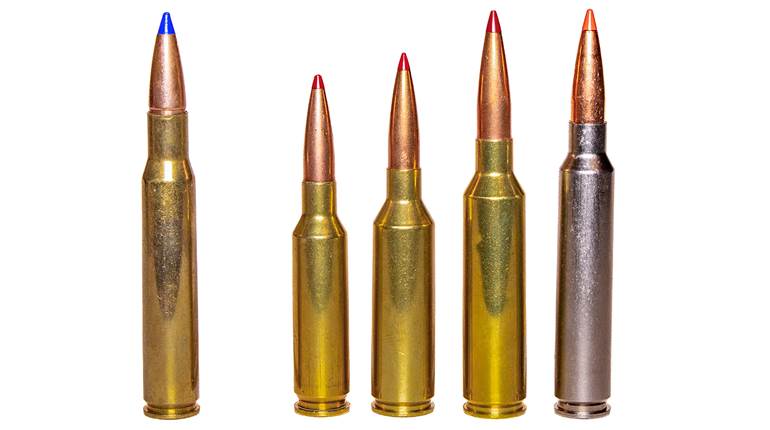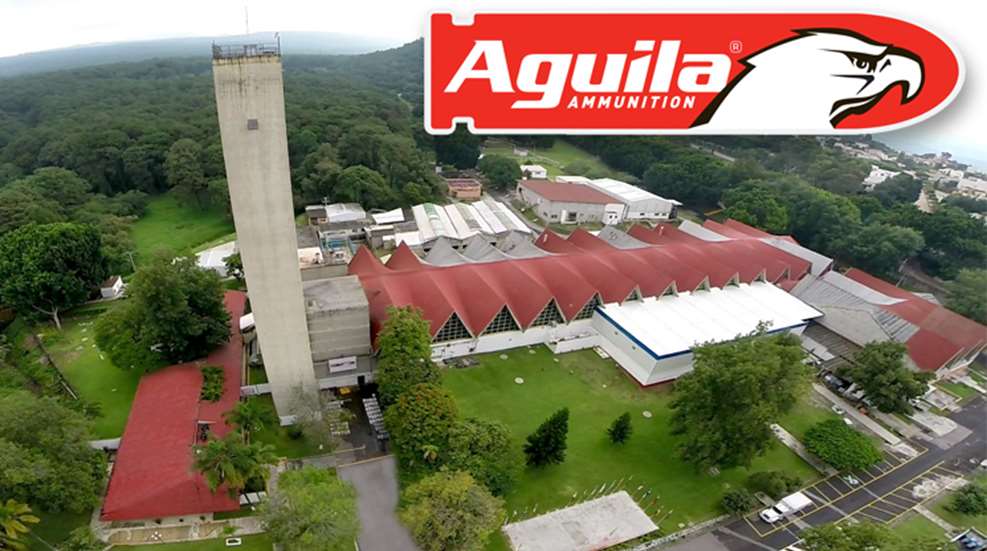
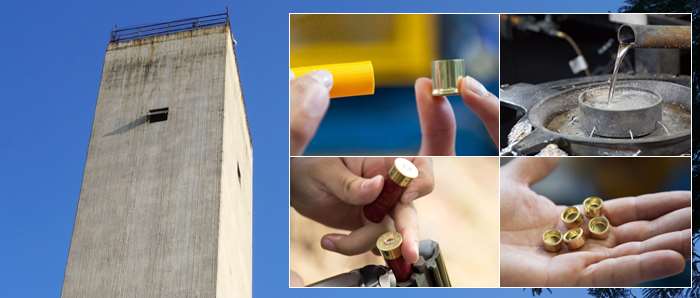
Recently, the demand for ammunition has exceeded the production capacity of American manufacturers. This has led to the increased importation of ammunition from various alternative sources. One of those that has seriously stepped up for American consumers is Aguila, Latin America’s foremost ammunition maker. The company, whose name means “eagle” in Spanish, has manufacturing facilities in Cuernavaca, Morelos, Mexico, that were originally used years ago by Remington. Established in 1961, Aguila today is the primary supplier of ammunition to the Mexican military (and others), and is one of the world’s largest producers of rimfire ammunition.
Aguila’s sole U.S. importer, Texas Armament & Technology in Houston, Texas, now offers a broad product line that includes rimfire, center-fire rifle and handgun cartridges, and shotshell loads. At a time when finding ammunition can be difficult, having options is good. So, in order to see if Aguila was one worthy of consideration, I decided to review 10 common rimfire and center-fire loads, shooting each through a variety of firearms. Descriptions of the loads and the shooting results follow, and shotshells are handled in a sidebar by NRA Publications Editorial Director John Zent.
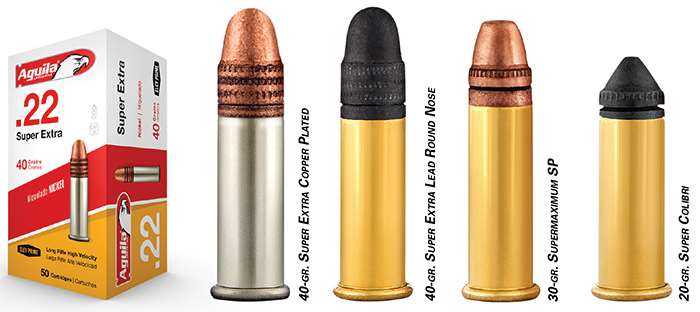
Rimfire
Aguila rimfire ammunition is manufactured using Eley Prime technology and utilizes clean, combustible propellants selected to provide maximum output at controlled pressures. Serious rimfire shooters have known for years that Aguila rimfire is quality ammunition, and the product line includes 15 loads divided among the .22 Short, .22 Long Rifle and .22 WMR and among three categories: Standard, Match and Special Products. The latter includes such unique offerings as the .22 Long Rifle 20-gr. Colibri (tested here) and the 60-gr. .22 Long Rifle Sniper Subsonic.
The rimfire loads I selected for testing all fell into the .22 Long Rifle category, by far the most popular, and were shot for accuracy using a New Ultra Light Arms (NULA) Model 20 single-shot rifle with a 22" barrel. Five-shot groups were fired with each load at 50 yds., and the remaining 75 rounds were function-tested through a semi-automatic Mossberg Blaze and a Browning 1911-22. Of the 400 total rounds fired throughout the evaluation, only two stoppages were noted.
Super Extra 40-gr. Copper Plated: This Standard load from Aguila proved to be a real tack driver; most groups were simply one ragged hole. If that’s your game, this is the load. For hunting squirrels and such, headshots would be the best bet due to the non-expanding 40-gr. Copper-plated bullet. As good as this load shot for me, that shouldn’t be a problem. Actual velocity was 29 f.p.s. slower than advertised.
Super Extra 40-gr. Lead Round Nose: Though not as accurate as the copper-plated 40-gr. load, this standard-velocity 40-gr. lead round-nose still shot well. Every group measured smaller than an inch at 50 yds., which is about par for the course with common rimfire loads. The actual muzzle velocity was 111 f.p.s. slower than advertised.
There were no stoppages in the Browning 1911-22, but there were two in the Mossberg Blaze—the first being the second shot from a full magazine where the cartridge failed to fully chamber. For what its worth, this has been a trend with this rifle/magazine combination and standard-velocity ammunition. The empty case from round number 32 stove-piped and had to be manually removed.
Supermaximum 30-gr. Copper Plated: This load is fast. CCI’s 32-gr. Stinger load has long been heralded as the fastest .22 Long Rifle load available. At about 1600 f.p.s. it is zippy. One issue with the Stinger is that the case/cartridge is a bit longer than a standard .22 Long Rifle load. This can cause reliability issues in some firearms. The Special Products Super Max load from Aguila also uses a slightly longer case, but it is 0.025" shorter than the Stinger. Overall cartridge length is 0.040" shorter, too.
The 30-gr. Supermaximum load was sizzling fast, averaging 100 f.p.s. faster than a CCI Stinger. So the Supermaximum moniker is fitting, and Aguila’s claim that it’s the fastest .22 Long Rifle load holds up; it delivered muzzle velocities 62 f.p.s. faster than advertised. Accuracy at 50 yds. was not stellar, but should be sufficient for moderate-size pests, and the hollow-point bullet should give a little extra smack on impact.
Super Colibri 20-gr. Lead: This is an interesting Special Products rimfire load from Aguila. It’s loaded in a .22 Long Rifle case but contains no gunpowder; propulsion is derived solely from the primer compound. As expected, velocities are very low at about 600 f.p.s. from a 22" barrel. (Advertised velocity is 420 f.p.s.) The intent was to accuracy test all rimfire loads at 50 yds. but the Colibri load was not intended for use at, nor up to, that range, so it was tested at 15 yds. Obviously, it would not cycle semi-automatic firearms.
What would you use it for? It would be a great training round for a young or new shooter. Ear protection, though always advised, is not mandatory due to the low report. This is always a good thing with new shooters, who can develop a flinch from noise. And, at 15 yds., the load was plenty accurate for busting balloons and tipping aluminum cans. It could also be used for whacking rats or other vermin in barns or other places where the use of full-power rimfire ammunition is ill-advised.
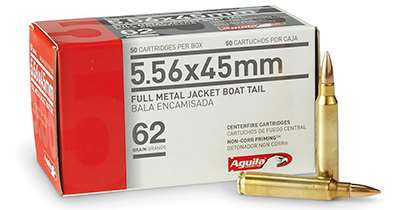
Center-Fire Rifle
Aguila offers fewer cartridges in its center-fire rifle line than others. In fact, it loads only four cartridges, but they are among those most commonly chambered in defensive rifles: .30 Carbine; .223 Rem.; 5.56x45 mm NATO; and 7.62x51 mm NATO. All share the key characteristics that might be expected from modern ammunition designed for training and general use—full-metal-jacket bullets and non-corrosive primers.
Five, five-shot groups were fired with the three selected loads at 100 yds. from a sandbag rest. Four rifles were used. The .223 Rem. and 5.56 mm NATO were tested in a Smith & Wesson M&P15 and a Mossberg MVP LR. A Remington Model 700 SPS and a DPMS GII were used for testing the 7.62 mm NATO load. One rifle was used for accuracy testing and the other to fire the remaining rounds provided. There were no stoppages related to feeding or extraction; however, there was one failure to fire.
.223 Rem. 55-gr.: This is a common 55-gr. FMJ load for the .223 Rem., and velocity was typical. Out of the 16"-barreled Smith & Wesson M&P15, topped with a Nightforce ATACR 4-14X riflescope, about 2.5 minute-of-angle (m.o.a.) was as precise as this load would shoot. It was not a tack-driver, but for general plinking and close-quarters dynamic shooting drills, it would be sufficient. The advertised muzzle velocity was listed at 3215 f.p.s., supposedly obtained with a 20" barrel.
5.56x45 mm NATO 62-gr.: This 62-gr. load features a boattail bullet design. It was a bit snappy, generating in excess of 2800 f.p.s. from the 16" barrel of the Mossberg MVP LR. For most steel target or general-practice drills, it was plenty accurate out to 300 yds. or so. This was proven from the bench out of the Mossberg and in practice out of the S&W M&P15.
This load produced the only true negative related to the testing of the almost 1,000 rounds of Aguila ammunition. Round three delivered only a slight “pop” and a trail of smoke out of the action. As it turns out, the primer ignited, pushed the cartridge forward past the extractor, and compressed the case into the chamber. This happened because the cartridge case did not have a flash hole. The cartridge had to be removed with a rod. The advertised velocity of this load from a 24" barrel is listed at 3150 f.p.s.
7.62x51 mm NATO 155-gr.: The .30-cal. NATO load was accuracy-tested out of a 20" barreled, Remington Model 700 SPS. Accuracy hovered around the 1.5 m.o.a. range, and there were no malfunctions when the load was fired from the DPMS GII. The actual muzzle velocity was only 15 f.p.s. less than the advertised 2750 f.p.s., which according to the Aguila website was obtained with a 24" barrel.

Center-Fire Handgun
The interesting thing about Aguila’s line of center-fire handgun ammunition is the variety of cartridges offered. Individually, there’s not a lot of selection, but of the 17 loads offered you’ll find less-common offerings such as the .25 ACP, .32 ACP, .32 S&W Long and .38 Super +P, which has always been a popular cartridge in Mexico. Most bullets are of the full-metal-jacket configuration, but a few lead-round-nose and jacketed-hollow-point offerings are included in the mix. Non-corrosive primers are used throughout.
The selected handgun loads were tested by firing five, five-shot groups at 25 yds., from a sandbag rest. The remaining 75 rounds were fired plinking and working through various drills. There were no stoppages related to feeding or extraction and no failures to fire.
9 mm Luger 117-gr. JHP: With an advertised velocity of 1250 f.p.s., this would seem to be a reasonably potent 9 mm Luger load. However, out of the test gun, a Wilson Combat Tactical Carry with a 5" barrel, actual muzzle velocity was only 1160 f.p.s. This is about what you would expect from a standard 115-gr. 9 mm Luger load. Accuracy was very good.
.38 Spl. 130-gr. FMJ: This load was tested in a Colt Single Action Army with a 5" barrel and factory sights. It produced an average muzzle velocity 41 f.p.s. slower than the advertised 850 f.p.s. Accuracy was exceptional, especially considering the Colt’s crude factory sights.
.45 ACP 230-gr. FMJ: Out of a Nighthawk Custom M1911 Commander with a 4.25" barrel, this 230-gr. FMJ load averaged 55 f.p.s. less than the advertised 830 f.p.s. muzzle velocity. It proved to be not only comfortable to shoot, it was very accurate, considering the short sight radius of the Commander.
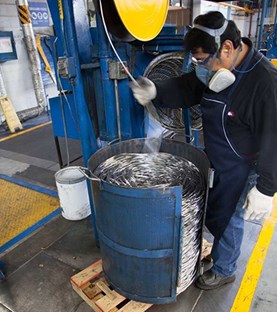 The Verdict
The Verdict
All told, I shot 940 rounds of Aguila ammunition over five days. Of those, the two rimfire rounds that failed to feed are of no real consequence since the same issues have been experienced with American-made rimfire ammunition in that same rifle/magazine combination. The cartridge case missing the flash hole is a different story. While unfortunate, it was not dangerous. And as poorly as it might seem to reflect on Aguila, it’s something that I’ve experienced with American, Soviet Bloc and Western European ammunition. Is it as frequent as a 1 in 1,000 occurrence? I doubt it, but have no data to support that assumption.
I was more than impressed with Aguila’s rimfire loads and have had good experiences with them in the past. I’d trust them for plinking, hunting and in some cases, competition. The same goes for the handgun loads. As for the center-fire rifle loads, none could be considered match-quality, but they are not offered as such. For most of the practical shooting any of us do, they would suffice.
Right now it can sometimes be easier to find a gallon of gas for less than $2 than to find the ammunition you want. If you see Aguila ammunition on the shelf, don’t pass it by—it works and is usually not overly expensive.
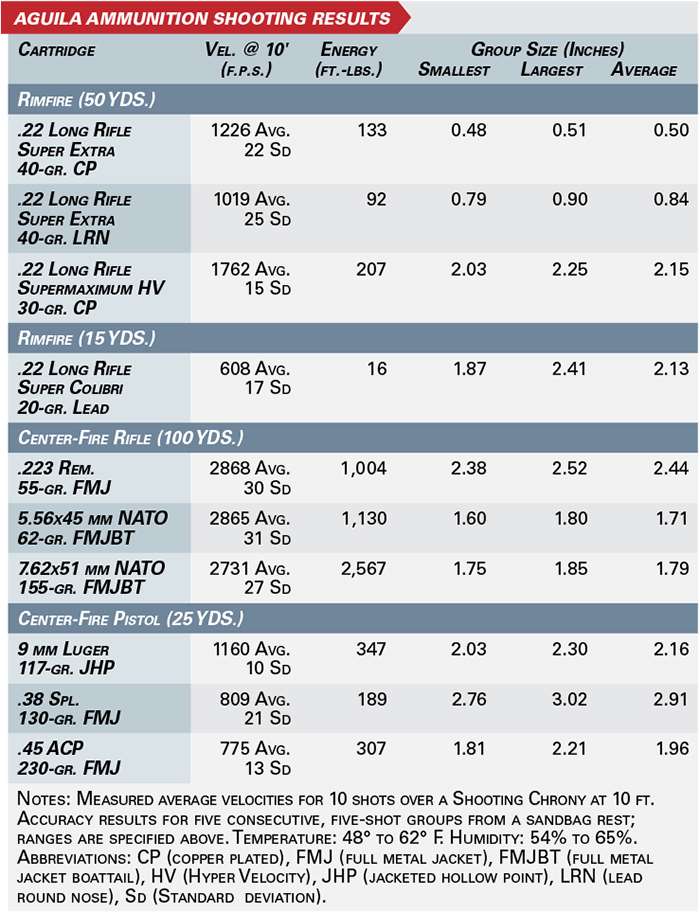
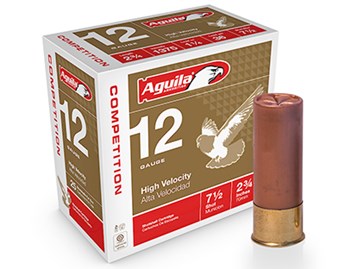 Shotshells:Not Just The Run Of The Mill
Shotshells:Not Just The Run Of The Mill
An ammunition industry executive recently told me that every year, 2 billion shotgun shells are sold in the United States. Despite that astounding volume, just a handful of well-known manufacturers dominate this market sector, especially match-grade shotshells. One big reason is that the few firms with the ability to manufacture large quantities of ultra-high-quality pellets tend to sell their own branded product, and so secondary brands are less prevalent than with other types of ammunition.
Nonetheless, we may be on the verge of seeing another significant player enter the fray. Aguila Ammunition from Mexico isn’t exactly a newcomer, but apart from encountering odd lots at gun shows, how many American shooters have first-hand experience with its cartridges?
Through its Texas importer, Aguila is bringing its innovative shotshell line to America in a move that includes plans for a nationwide retail network designed to make it easy for shooters to obtain these shells at affordable pricing.
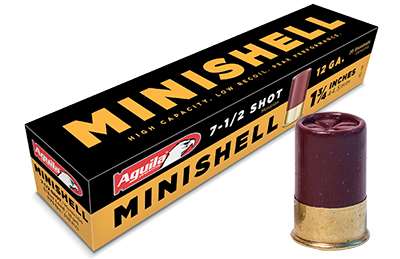
Shotshells: Aguila Makes Those, Too
Clays enthusiasts who go through shells by the caseload could take particular note. Aguila offers a line for skeet, trap and sporting clays bearing Nos. 7½, 8 and 9 shot in standard- and high-velocity 12-ga. rounds, as well as an exclusive pigeon load.
Along with a small group of other Americans, I got the chance to try some of the match loads first-hand during an international sporting clays tournament hosted by Aguila in Acapulco, Mexico, in late September of last year. Over two extremely hot, humid days, we tackled a 200-bird sporting clays course that was maddeningly difficult, even for the professional shooters who made the trip.
One of them was world champion Derrick Mein from the USA Sporting Clays Team, who ultimately was the event’s high scorer at 180x200. I had the good (if humbling) fortune of being squadded with Derrick, and after witnessing his exceptional shooting, asked his take on the Aguila shells.
The champ, who routinely shoots more clays than most of us can imagine, offered two reasons in particular why he was impressed and came away convinced the Aguilas can hold their own in the demanding tournament arena. First, he noted the roundness of the pellets, having cut shells apart to examine them. Mein said they are as perfectly spherical as other top brands, which is what’s necessary for optimum pattern density and consistency. He said he can tell from the manner the birds were breaking that his patterns were first-rate. Mein also cited uniform velocity as a reason why the Aguila shells performed so well. Because he shoots so much, he said he can sense small variances in recoil that indicate velocity fluctuations, which in turn can lead to missed targets.
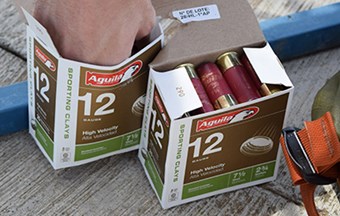 During the tourney I met Rod Taylor, Aguila’s director of manufacturing, who filled me in on his firm’s quality control. He told me that the company’s 72-meter shot tower produces shot in the time-honored method that some top shotgunners believe is the only avenue to truly round pellets, and while mainstream makers such as Winchester and Remington also employ shot towers, other companies rely on alternate methods. Given the expense involved, it’s unlikely we’ll be hearing about any newly constructed shot towers, and so the fact that Aguila uses one is a testament to its unique ability to compete in a tough, but busy, market segment.
During the tourney I met Rod Taylor, Aguila’s director of manufacturing, who filled me in on his firm’s quality control. He told me that the company’s 72-meter shot tower produces shot in the time-honored method that some top shotgunners believe is the only avenue to truly round pellets, and while mainstream makers such as Winchester and Remington also employ shot towers, other companies rely on alternate methods. Given the expense involved, it’s unlikely we’ll be hearing about any newly constructed shot towers, and so the fact that Aguila uses one is a testament to its unique ability to compete in a tough, but busy, market segment.
The product introduction also features bold, new packaging designed to command attention at the retail level. In addition to match loads, Aguila produces shotshells for hunting and home defense. In the latter category, shooters will find the unique Aguila 12 Minishell, a 1¾" 12-ga. containing 5/8-oz. payloads of No. 4 Buck or No. 7½ shot, and there’s also a Minishell slug. The prospect of greatly increased magazine capacity is attracting a cult-like following to the Mini among some home defenders and, as a low-recoil training or plinking round, the Minishell is in a league of its own.
—John R. Zent, Editorial Director
For more information, contact:
Texas Armament & Technology (Dept. AR), 15850 Vickery Drive, Houston, TX 77032; (888) 452-4019; aguilaammo.com.













